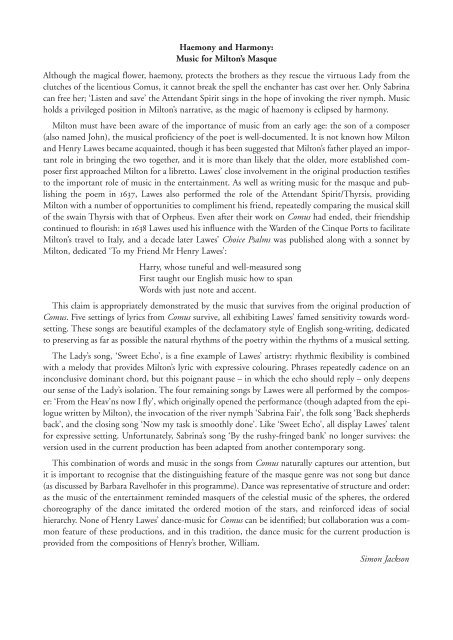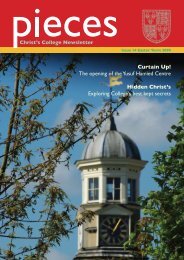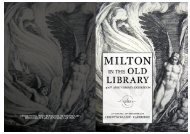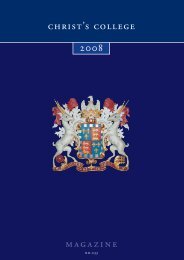here - Christ's College - University of Cambridge
here - Christ's College - University of Cambridge
here - Christ's College - University of Cambridge
You also want an ePaper? Increase the reach of your titles
YUMPU automatically turns print PDFs into web optimized ePapers that Google loves.
Haemony and Harmony:<br />
Music for Milton’s Masque<br />
Although the magical flower, haemony, protects the brothers as they rescue the virtuous Lady from the<br />
clutches <strong>of</strong> the licentious Comus, it cannot break the spell the enchanter has cast over her. Only Sabrina<br />
can free her; ‘Listen and save’ the Attendant Spirit sings in the hope <strong>of</strong> invoking the river nymph. Music<br />
holds a privileged position in Milton’s narrative, as the magic <strong>of</strong> haemony is eclipsed by harmony.<br />
Milton must have been aware <strong>of</strong> the importance <strong>of</strong> music from an early age: the son <strong>of</strong> a composer<br />
(also named John), the musical pr<strong>of</strong>iciency <strong>of</strong> the poet is well-documented. It is not known how Milton<br />
and Henry Lawes became acquainted, though it has been suggested that Milton’s father played an important<br />
role in bringing the two together, and it is more than likely that the older, more established composer<br />
first approached Milton for a libretto. Lawes’ close involvement in the original production testifies<br />
to the important role <strong>of</strong> music in the entertainment. As well as writing music for the masque and publishing<br />
the poem in 1637, Lawes also performed the role <strong>of</strong> the Attendant Spirit/Thyrsis, providing<br />
Milton with a number <strong>of</strong> opportunities to compliment his friend, repeatedly comparing the musical skill<br />
<strong>of</strong> the swain Thyrsis with that <strong>of</strong> Orpheus. Even after their work on Comus had ended, their friendship<br />
continued to flourish: in 1638 Lawes used his influence with the Warden <strong>of</strong> the Cinque Ports to facilitate<br />
Milton’s travel to Italy, and a decade later Lawes’ Choice Psalms was published along with a sonnet by<br />
Milton, dedicated ‘To my Friend Mr Henry Lawes’:<br />
Harry, whose tuneful and well-measured song<br />
First taught our English music how to span<br />
Words with just note and accent.<br />
This claim is appropriately demonstrated by the music that survives from the original production <strong>of</strong><br />
Comus. Five settings <strong>of</strong> lyrics from Comus survive, all exhibiting Lawes’ famed sensitivity towards wordsetting.<br />
These songs are beautiful examples <strong>of</strong> the declamatory style <strong>of</strong> English song-writing, dedicated<br />
to preserving as far as possible the natural rhythms <strong>of</strong> the poetry within the rhythms <strong>of</strong> a musical setting.<br />
The Lady’s song, ‘Sweet Echo’, is a fine example <strong>of</strong> Lawes’ artistry: rhythmic flexibility is combined<br />
with a melody that provides Milton’s lyric with expressive colouring. Phrases repeatedly cadence on an<br />
inconclusive dominant chord, but this poignant pause – in which the echo should reply – only deepens<br />
our sense <strong>of</strong> the Lady’s isolation. The four remaining songs by Lawes were all performed by the composer:<br />
‘From the Heav’ns now I fly’, which originally opened the performance (though adapted from the epilogue<br />
written by Milton), the invocation <strong>of</strong> the river nymph ‘Sabrina Fair’, the folk song ‘Back shepherds<br />
back’, and the closing song ‘Now my task is smoothly done’. Like ‘Sweet Echo’, all display Lawes’ talent<br />
for expressive setting. Unfortunately, Sabrina’s song ‘By the rushy-fringed bank’ no longer survives: the<br />
version used in the current production has been adapted from another contemporary song.<br />
This combination <strong>of</strong> words and music in the songs from Comus naturally captures our attention, but<br />
it is important to recognise that the distinguishing feature <strong>of</strong> the masque genre was not song but dance<br />
(as discussed by Barbara Ravelh<strong>of</strong>er in this programme). Dance was representative <strong>of</strong> structure and order:<br />
as the music <strong>of</strong> the entertainment reminded masquers <strong>of</strong> the celestial music <strong>of</strong> the sp<strong>here</strong>s, the ordered<br />
choreography <strong>of</strong> the dance imitated the ordered motion <strong>of</strong> the stars, and reinforced ideas <strong>of</strong> social<br />
hierarchy. None <strong>of</strong> Henry Lawes’ dance-music for Comus can be identified; but collaboration was a common<br />
feature <strong>of</strong> these productions, and in this tradition, the dance music for the current production is<br />
provided from the compositions <strong>of</strong> Henry’s brother, William.<br />
Simon Jackson





